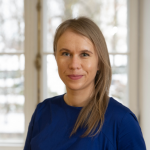Foresight Centre: Shortage of teachers and support specialists is limiting study opportunities for Ukrainian children
According to the report “Ukrainian Children in the Estonian Education System”, published by the Foresight Centre, the Estonian schools and kindergartens are generally managing well the extra workload that came with the Ukrainian refugee pupils, but the shortage of teachers and support specialists is putting schools in a very unequal position when it comes to Ukrainian children.

In the opinion of the schools that have accepted Ukrainian children, the Ukrainian pupils have adapted well or fairly well. “The largest number of Ukrainian refugee children have come to the municipalities where the number of pupils per teacher was already the highest, which is making the problem of teacher shortage and overburden more acute. The main challenges for teachers are the language barrier and teaching in bilingual classrooms, the big differences between the Estonian and Ukrainian curricula, and helping the Ukrainian students catch up with others,” Expert of the Foresight Centre Eneli Kindsiko pointed out.
The workload of Estonian teachers is eased by Ukrainian education workers and war refugee volunteers, who are helping translate teaching materials and give lessons or act as support persons for children. 104 war refugees have taken up work in the schools of Estonia.
As at mid-February, 8463 Ukrainian children were studying in the educational institutions of Estonia, that is, on average, 3% of all pupils in Estonia. Most of the Ukrainian pupils are in Harju County, where the children of Ukrainian war refugees are accounting for 4%. Nearly half, or 45.5% of Ukrainian children in Estonia go to school in Tallinn. Tartu (9.9%) and Pärnu (4.5%) come after Tallinn as regards the number of Ukrainian pupils.
Top ten of local governments by the number of Ukrainian pupils:
1. City of Tallinn 3850
2. City of Tartu 839
3. City of Pärnu 381
4. City of Kohtla-Järve 240
5. City of Maardu 189
6. City of Rakvere 181
7. Saaremaa Rural Municipality 175
8. City of Narva 158
9. City of Sillamäe 117
10. Lääne-Harju Rural Municipality
63% of Ukrainian children are studying in Estonian. “However, it should be noted that even if the children are going to schools where Estonian is the language of instruction, they may still receive instruction in Russian or Ukrainian to some extent, and a large proportion of pupils are studying via the language immersion method,” Kindsiko said.
The highest proportion of the Ukrainian children studying in Russian or English are in East-Viru and Harju Counties. In Harju County, 33% of the Ukrainian children who have arrived in the county are studying in Russian, while the figure is 52% in East-Viru County.
The experience perceived by teachers and heads of school so far has confirmed that the easiest way to integrate Ukrainian children into the education system is in pre-school education, that is, at a younger age. The more complex the content of a subject becomes, the more difficult it is to participate in the studies in the Estonian language without having a basic level of language skills. However, the majority of the children who have arrived from Ukraine are of a basic education age (65%), and 24% of all war refugee children that have arrived in Estonia are in pre-school education.
The brief report “Ukrainian Children in the Estonian Education System” is a part of the Foresight Centre study „The Future for the Next Generation of Teachers“. The aim of the Foresight Centre study is to develop the scenarios of the need for teachers and the future of the teaching profession until 2040 on the basis of global and national trends.
Latest news
-
27.06 2025Current low birth rate will lead to up to 1.3 billion euros less tax revenue in the future
In its new short report “The impact of population ageing and low birth rate on long-term state revenue and expenditure”, the Foresight Centre notes that the lower than projected birth rate will reduce government spending on family policy and education, but in the long term, it will mean up to 1.3 billion euros less in tax revenue.

 An independent think tank at the Riigikogu
An independent think tank at the Riigikogu 